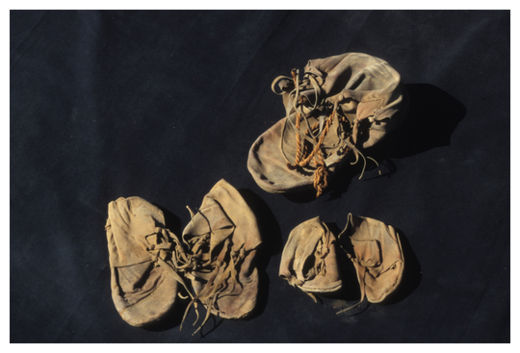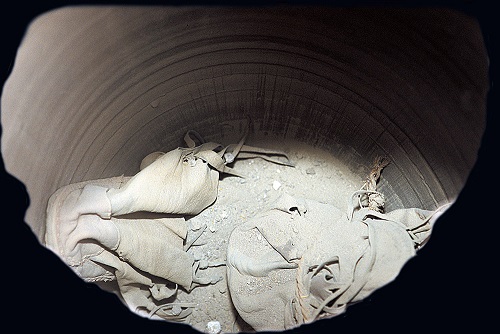
Two pairs of tiny children's shoes were among the seven found concealed in a jar placed into a cavity between two mudbrick walls in a temple in Luxor, site of the ancient city of Thebes.
Oddly, they were tied together using palm fibre string and placed within a single adult shoe. A third pair that had been worn by an adult was found alongside them.
But there is no clue as to why the shoes, which would have been costly and unusual footwear for the era, were never retrieved after they were left in the temple just over 2,000 years ago when Egypt was ruled by a dynasty of Greek descent.
Research has shown that at least one of them includes structural elements that historians had previously believed were not invented until the Medieval era, which began in Europe some 500 years later.
At the time the shoes were concealed, most Egyptians would normally have worn sandals.
The shoes were discovered by an Italian archaeological team in 2004, but a new study has now offered fresh insights into them.
André Veldmeijer, assistant director of the Netherlands-Flemish Institute in Cairo and an expert in ancient Egyptian footwear, says it is likely the shoes were foreign made and 'relatively expensive'.
'The find is extraordinary as the shoes were in pristine condition and still supple upon discovery,' wrote Dr Veldmeijer in the most recent issue of the Journal of the American Research Center in Egypt.
Unfortunately, he added, after they were unearthed the shoes became brittle and 'extremely fragile'.

After being shown photographs of the seven shoes, Dr Veldmeijer made a number of discoveries about their design.
Most surprising was that the single shoe discovered with the child's pairs inside was made with a feature that shoemakers know as a 'rand' - a structural device that was thought to have been first used in Medieval Europe.
Folded leather strips that go between the soles and the upper parts of shoes, rands reinforce the stitching as 'the upper is very prone to tear apart at the stitch holes', Dr Veldmeijer told LiveScience.
They would be useful in muddy conditions where shoes are under pressure, so to find the device in the dry climate of Egypt is surprising and indicates that the shoes were made somewhere abroad.
Dr Veldmeijer also found that the shoes' owners would have tied them using what researchers call 'tailed toggles', which are leather strips that pass through at the top of the shoes.
After they were knotted into place a long strip of leather would have hung down decoratively on either side.
Dr Veldmaijer's analysis of the shoes also revealed insights into the health of their owners.
He found a semi-circular protruding area in one that could have been caused by a bunion, while of the pair of adult shoes the left had more patches and evidence of repair than the right.
'The shoe was exposed to unequal pressure,' he told LiveScience, which showed that person who wore it 'walked with a limp, otherwise the wear would have been far more equal'.
The wear and tear and subsequent repair showed that the people who wore them valued the shoes as 'highly prized commodities', Dr Veldmeijer said, deepening the mystery of why they were left in the temple.
'There's no reason to store them without having the intention of getting them back at some point,' he told LiveScience.
He speculated that there could have been some kind of unrest that spurred the owners to leave their fancy shoes behind and flee hastily.



Reader Comments
to our Newsletter